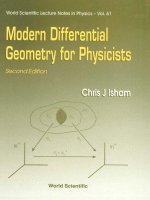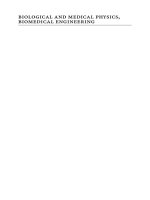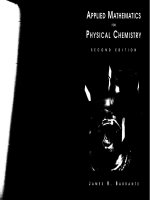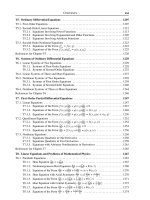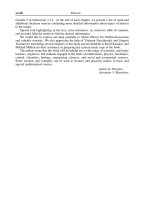- Trang chủ >>
- Khoa Học Tự Nhiên >>
- Vật lý
Mathematics for physicists
Bạn đang xem bản rút gọn của tài liệu. Xem và tải ngay bản đầy đủ của tài liệu tại đây (4.71 MB, 584 trang )
www.pdfgrip.com
Mathematics for Physicists
www.pdfgrip.com
The Manchester Physics Series
General Editors
J.R. FORSHAW, H.F. GLEESON, F.K. LOEBINGER
School of Physics and Astronomy,
University of Manchester
Properties of Matter
B.H. Flowers and E. Mendoza
Statistical Physics
Second Edition
F. Mandl
Electromagnetism
Second Edition
l.S. Grant and W.R. Phillips
Statistics
R.J. Barlow
Solid State Physics
Second Edition
J.R. Hook and H.E. Hall
Quantum Mechanics
F. Mandl
Computing for Scientists
R.J. Barlow and A.R. Barnett
The Physics of Stars
Second Edition
A.C. Phillips
Nuclear Physics
J.S. Lilley
Introduction to Quantum Mechanics
A.C. Phillips
Particle Physics
Third Edition
B.R. Martin and G. Shaw
Dynamics and Relativity
J.R. Forshaw and A.G. Smith
Vibrations and Waves
G.C. King
Mathematics for Physicists
B.R. Martin and G. Shaw
www.pdfgrip.com
Mathematics for Physicists
B.R. MARTIN
Department of Physics and Astronomy
University College London
G. SHAW
Department of Physics and Astronomy
Manchester University
www.pdfgrip.com
This edition first published 2015
© 2015 John Wiley & Sons, Ltd
Registered office
John Wiley & Sons Ltd, The Atrium, Southern Gate, Chichester, West Sussex, PO19 8SQ, United Kingdom
For details of our global editorial offices, for customer services and for information about how to apply for
permission to reuse the copyright material in this book please see our website at www.wiley.com.
The right of the author to be identified as the author of this work has been asserted in accordance with the
Copyright, Designs and Patents Act 1988.
All rights reserved. No part of this publication may be reproduced, stored in a retrieval system, or transmitted,
in any form or by any means, electronic, mechanical, photocopying, recording or otherwise, except as permitted
by the UK Copyright, Designs and Patents Act 1988, without the prior permission of the publisher.
Wiley also publishes its books in a variety of electronic formats. Some content that appears in print may not be
available in electronic books.
Designations used by companies to distinguish their products are often claimed as trademarks. All brand names
and product names used in this book are trade names, service marks, trademarks or registered trademarks of
their respective owners. The publisher is not associated with any product or vendor mentioned in this book.
Limit of Liability/Disclaimer of Warranty: While the publisher and author have used their best efforts in
preparing this book, they make no representations or warranties with respect to the accuracy or completeness of
the contents of this book and specifically disclaim any implied warranties of merchantability or fitness for a
particular purpose. It is sold on the understanding that the publisher is not engaged in rendering professional
services and neither the publisher nor the author shall be liable for damages arising herefrom. If professional
advice or other expert assistance is required, the services of a competent professional should be sought.
The advice and strategies contained herein may not be suitable for every situation. In view of ongoing research,
equipment modifications, changes in governmental regulations, and the constant flow of information relating to
the use of experimental reagents, equipment, and devices, the reader is urged to review and evaluate the
information provided in the package insert or instructions for each chemical, piece of equipment, reagent, or
device for, among other things, any changes in the instructions or indication of usage and for added warnings
and precautions. The fact that an organization or Website is referred to in this work as a citation and/or a
potential source of further information does not mean that the author or the publisher endorses the information
the organization or Website may provide or recommendations it may make. Further, readers should be aware
that Internet Websites listed in this work may have changed or disappeared between when this work was written
and when it is read. No warranty may be created or extended by any promotional statements for this work.
Neither the publisher nor the author shall be liable for any damages arising herefrom.
Library of Congress Cataloging-in-Publication Data.
Martin, B. R. (Brian Robert), author.
Mathematics for physicists / B.R. Martin, G. Shaw.
pages cm
Includes bibliographical references and index.
ISBN 978-0-470-66023-2 (cloth) – ISBN 978-0-470-66022-5 (pbk.)
physics. I. Shaw, G. (Graham), 1942– author. II. Title.
QC20.M35 2015
510–dc23
1. Mathematics.
2. Mathematical
2015008518
Set in 11/13pt Computer Modern by Aptara Inc., New Delhi, India.
1
2015
www.pdfgrip.com
Contents
Editors’ preface to the Manchester Physics Series
Authors’ preface
xi
xiii
Notes and website information
xv
1
Real numbers, variables and functions
1.1
Real numbers
1.1.1 Rules of arithmetic: rational and irrational numbers
1.1.2 Factors, powers and rationalisation
*1.1.3 Number systems
1.2
Real variables
1.2.1 Rules of elementary algebra √
*1.2.2 Proof of the irrationality of 2
1.2.3 Formulas, identities and equations
1.2.4 The binomial theorem
1.2.5 Absolute values and inequalities
1.3
Functions, graphs and co-ordinates
1.3.1 Functions
1.3.2 Cartesian co-ordinates
Problems 1
1
1
1
4
6
9
9
11
11
13
17
20
20
23
28
2
Some basic functions and equations
2.1
Algebraic functions
2.1.1 Polynomials
2.1.2 Rational functions and partial fractions
2.1.3 Algebraic and transcendental functions
2.2
Trigonometric functions
2.2.1 Angles and polar co-ordinates
2.2.2 Sine and cosine
2.2.3 More trigonometric functions
2.2.4 Trigonometric identities and equations
2.2.5 Sine and cosine rules
2.3
Logarithms and exponentials
2.3.1 The laws of logarithms
2.3.2 Exponential function
2.3.3 Hyperbolic functions
2.4
Conic sections
Problems 2
31
31
31
37
41
41
41
44
46
48
51
53
54
56
60
63
68
www.pdfgrip.com
vi
Contents
3
Differential calculus
3.1
Limits and continuity
3.1.1 Limits
3.1.2 Continuity
3.2
Differentiation
3.2.1 Differentiability
3.2.2 Some standard derivatives
3.3
General methods
3.3.1 Product rule
3.3.2 Quotient rule
3.3.3 Reciprocal relation
3.3.4 Chain rule
3.3.5 More standard derivatives
3.3.6 Implicit functions
3.4
Higher derivatives and stationary points
3.4.1 Stationary points
3.5
Curve sketching
Problems 3
4
Integral calculus
4.1
Indefinite integrals
4.2
Definite integrals
4.2.1 Integrals and areas
4.2.2 Riemann integration
4.3
Change of variables and substitutions
4.3.1 Change of variables
4.3.2 Products of sines and cosines
4.3.3 Logarithmic integration
4.3.4 Partial fractions
4.3.5 More standard integrals
4.3.6 Tangent substitutions
4.3.7 Symmetric and antisymmetric integrals
4.4
Integration by parts
4.5
Numerical integration
4.6
Improper integrals
4.6.1 Infinite integrals
4.6.2 Singular integrals
4.7
Applications of integration
4.7.1 Work done by a varying force
4.7.2 The length of a curve
*4.7.3 Surfaces and volumes of revolution
*4.7.4 Moments of inertia
Problems 4
101
101
104
105
108
111
111
113
115
116
117
118
119
120
123
126
126
129
132
132
133
134
136
137
5
Series and expansions
5.1
Series
5.2
Convergence of infinite series
143
143
146
www.pdfgrip.com
71
71
71
75
77
78
80
82
83
83
84
86
87
89
90
92
95
98
Contents
Taylor’s theorem and its applications
5.3.1 Taylor’s theorem
5.3.2 Small changes and l’Hˆ
opital’s rule
5.3.3 Newton’s method
*5.3.4 Approximation errors: Euler’s number
5.4
Series expansions
5.4.1 Taylor and Maclaurin series
5.4.2 Operations with series
*5.5
Proof of d’Alembert’s ratio test
*5.5.1 Positive series
*5.5.2 General series
*5.6
Alternating and other series
Problems 5
6
7
8
vii
5.3
149
149
150
152
153
153
154
157
161
161
162
163
165
Complex numbers and variables
6.1
Complex numbers
6.2
Complex plane: Argand diagrams
6.3
Complex variables and series
*6.3.1 Proof of the ratio test for complex series
6.4
Euler’s formula
6.4.1 Powers and roots
6.4.2 Exponentials and logarithms
6.4.3 De Moivre’s theorem
*6.4.4 Summation of series and evaluation of integrals
Problems 6
169
169
172
176
179
180
182
184
185
187
189
Partial differentiation
7.1
Partial derivatives
7.2
Differentials
7.2.1 Two standard results
7.2.2 Exact differentials
7.2.3 The chain rule
7.2.4 Homogeneous functions and Euler’s theorem
7.3
Change of variables
7.4
Taylor series
7.5
Stationary points
*7.6
Lagrange multipliers
*7.7
Differentiation of integrals
Problems 7
Vectors
8.1
Scalars and vectors
8.1.1 Vector algebra
8.1.2 Components of vectors: Cartesian co-ordinates
8.2
Products of vectors
8.2.1
Scalar product
8.2.2
Vector product
www.pdfgrip.com
191
191
193
195
197
198
199
200
203
206
209
211
214
219
219
220
221
225
225
228
viii
9
10
11
Contents
8.2.3
Triple products
*8.2.4
Reciprocal vectors
8.3
Applications to geometry
8.3.1
Straight lines
8.3.2
Planes
8.4
Differentiation and integration
Problems 8
231
236
238
238
241
243
246
Determinants, Vectors and Matrices
9.1
Determinants
9.1.1
General properties of determinants
9.1.2
Homogeneous linear equations
9.2
Vectors in n Dimensions
9.2.1
Basis vectors
9.2.2
Scalar products
9.3
Matrices and linear transformations
9.3.1
Matrices
9.3.2
Linear transformations
9.3.3
Transpose, complex, and Hermitian conjugates
9.4
Square Matrices
9.4.1
Some special square matrices
9.4.2
The determinant of a matrix
9.4.3
Matrix inversion
9.4.4
Inhomogeneous simultaneous linear equations
Problems 9
249
249
253
257
260
261
263
265
265
270
273
274
274
276
278
282
284
Eigenvalues and eigenvectors
10.1 The eigenvalue equation
10.1.1 Properties of eigenvalues
10.1.2 Properties of eigenvectors
10.1.3 Hermitian matrices
*10.2 Diagonalisation of matrices
*10.2.1 Normal modes of oscillation
*10.2.2 Quadratic forms
Problems 10
Line and multiple integrals
11.1 Line integrals
11.1.1 Line integrals in a plane
11.1.2 Integrals around closed contours and along arcs
11.1.3 Line integrals in three dimensions
11.2 Double integrals
11.2.1 Green’s theorem in the plane and perfect differentials
11.2.2 Other co-ordinate systems and change of variables
11.3 Curvilinear co-ordinates in three dimensions
11.3.1 Cylindrical and spherical polar co-ordinates
www.pdfgrip.com
291
291
293
296
299
302
305
308
312
315
315
315
319
321
323
326
330
333
334
Contents
ix
11.4
Triple or volume integrals
11.4.1 Change of variables
Problems 11
337
338
340
12
Vector calculus
12.1 Scalar and vector fields
12.1.1 Gradient of a scalar field
12.1.2 Div, grad and curl
12.1.3 Orthogonal curvilinear co-ordinates
12.2 Line, surface, and volume integrals
12.2.1 Line integrals
12.2.2 Conservative fields and potentials
12.2.3 Surface integrals
12.2.4 Volume integrals: moments of inertia
12.3 The divergence theorem
12.3.1 Proof of the divergence theorem and Green’s identities
*12.3.2 Divergence in orthogonal curvilinear co-ordinates
*12.3.3 Poisson’s equation and Gauss’ theorem
*12.3.4 The continuity equation
12.4 Stokes’ theorem
12.4.1 Proof of Stokes’ theorem
*12.4.2 Curl in curvilinear co-ordinates
*12.4.3 Applications to electromagnetic fields
Problems 12
345
345
346
349
352
355
355
359
362
367
368
369
372
373
376
377
378
380
381
384
13
Fourier analysis
13.1 Fourier series
13.1.1 Fourier coefficients
13.1.2 Convergence
13.1.3 Change of period
13.1.4 Non-periodic functions
13.1.5 Integration and differentiation of Fourier series
13.1.6 Mean values and Parseval’s theorem
13.2 Complex Fourier series
*13.2.1 Fourier expansions and vector spaces
13.3 Fourier transforms
13.3.1 Properties of Fourier transforms
*13.3.2 The Dirac delta function
*13.3.3 The convolution theorem
Problems 13
389
389
390
394
398
399
401
405
407
409
410
414
419
423
426
14
Ordinary differential equations
14.1 First-order equations
14.1.1 Direct integration
14.1.2 Separation of variables
14.1.3 Homogeneous equations
431
433
433
434
435
www.pdfgrip.com
x
Contents
14.1.4 Exact equations
14.1.5 First-order linear equations
14.2 Linear ODEs with constant coefficients
14.2.1 Complementary functions
14.2.2 Particular integrals: method of undetermined coefficients
*14.2.3 Particular integrals: the D-operator method
*14.2.4 Laplace transforms
*14.3 Euler’s equation
Problems 14
15
16
Series solutions of ordinary differential equations
15.1 Series solutions
15.1.1 Series solutions about a regular point
15.1.2 Series solutions about a regular singularity: Frobenius method
15.1.3 Polynomial solutions
15.2 Eigenvalue equations
15.3 Legendre’s equation
15.3.1 Legendre functions and Legendre polynomials
*15.3.2 The generating function
*15.3.3 Associated Legendre equation
*15.3.4 Rodrigues’ formula
15.4 Bessel’s equation
15.4.1 Bessel functions
*15.4.2 Properties of non-singular Bessel functions Jν (x)
Problems 15
Partial differential equations
16.1 Some important PDEs in physics
16.2 Separation of variables: Cartesian co-ordinates
16.2.1 The wave equation in one spatial dimension
16.2.2 The wave equation in three spatial dimensions
16.2.3 The diffusion equation in one spatial dimension
16.3 Separation of variables: polar co-ordinates
16.3.1 Plane-polar co-ordinates
16.3.2 Spherical polar co-ordinates
16.3.3 Cylindrical polar co-ordinates
*16.4 The wave equation: d’Alembert’s solution
*16.5 Euler equations
*16.6 Boundary conditions and uniqueness
*16.6.1 Laplace transforms
Problems 16
438
440
441
442
446
448
453
459
461
465
465
467
469
475
478
481
482
487
490
492
494
495
499
502
507
510
511
512
515
518
520
520
524
529
532
535
538
540
544
Answers to selected problems
549
Index
559
www.pdfgrip.com
Editors’ preface to the Manchester Physics Series
The Manchester Physics Series is a set of textbooks at first degree level. It grew out of the
experience at the University of Manchester, widely shared elsewhere, that many textbooks contain much more material than can be accommodated in a typical undergraduate course; and
that this material is only rarely so arranged as to allow the definition of a short self-contained
course. The plan for this series was to produce short books so that lecturers would find them
attractive for undergraduate courses, and so that students would not be frightened off by their
encyclopaedic size or price. To achieve this, we have been very selective in the choice of topics,
with the emphasis on the basic physics together with some instructive, stimulating and useful
applications.
Although these books were conceived as a series, each of them is self-contained and can be
used independently of the others. Several of them are suitable for wider use in other sciences.
Each Author’s Preface gives details about the level, prerequisites, etc., of that volume.
The Manchester Physics Series has been very successful since its inception over 40 years
ago, with total sales of more than a quarter of a million copies. We are extremely grateful
to the many students and colleagues, at Manchester and elsewhere, for helpful criticisms and
stimulating comments. Our particular thanks go to the authors for all the work they have done,
for the many new ideas they have contributed, and for discussing patiently, and often accepting,
the suggestions of the editors.
Finally, we would like to thank our publisher, John Wiley & Sons, Ltd., for their enthusiastic
and continued commitment to the Manchester Physics Series.
J. R. Forshaw
H. F. Gleeson
F. K. Loebinger
August 2014
www.pdfgrip.com
www.pdfgrip.com
Authors’ preface
Our aim in writing this book is to produce a relatively short volume that covers all the essential
mathematics needed for a typical first degree in physics, from a starting point that is compatible
with modern school mathematics syllabuses. Thus, it differs from most books, which include
many advanced topics, such as tensor analysis, group theory, etc., that are not required in a
typical physics degree course, except as specialised options. These books are frequently well
over a thousand pages long and contain much more material than most undergraduate students
need. In addition, they are often not well interfaced with school mathematics and start at a level
that is no longer appropriate. Mathematics teaching at schools has changed over the years and
students now enter university with a wide variety of mathematical backgrounds.
The early chapters of the book deliberately overlap with senior school mathematics, to a
degree that will depend on the background of the individual reader, who may quickly skip over
those topics with which he or she is already familiar. The rest of the book covers the mathematics
that is usually compulsory for all students in their first two years of a typical university physics
degree, plus a little more. Although written primarily for the needs of physics students, it would
also be appropriate for students in other physical sciences, such as astronomy, chemistry, earth
science, etc.
We do not try to cover all the more advanced, optional courses taken by some physics students,
since these are already well treated in more advanced texts, which, with some degree of overlap,
take up where our book leaves off. The exception is statistics. Although this is required by
undergraduate physics students, we have not included it because it is usually taught as a separate
topic, using one of the excellent specialised texts already available.
The book has been read in its entirety by one of the editors of the Manchester Physics Series,
Jeff Forshaw of Manchester University, and we are grateful to him for many helpful suggestions
that have improved the presentation.
B.R. Martin
G. Shaw
April 2015
www.pdfgrip.com
www.pdfgrip.com
Notes and website information
‘Starred’ material
Some sections of the book are marked with a star. These contain more specialised or advanced
material that is not required elsewhere in the book and may be omitted at a first reading.
Website
Any misprints or other necessary corrections brought to our attention will be listed on
www.wiley.com/go/martin/mathsforphysicists. We would also be grateful for any other comments about the book.
Examples, problems and solutions
Worked examples are given in all chapters. They are an integral part of the text and are designed
to illustrate applications of material discussed in the preceding section. There is also a set of
problems at the end of each chapter. Some equations which are particularly useful in problem solving are highlighted in the text for ease of access and brief ‘one-line’ answers to most
problems are given at the end of the book, so that readers may quickly check whether their
own answer is correct. Readers may access the full solutions to all the odd-numbered problems
at www.wiley.com/go/martin/mathsforphysicists. Full solutions to all problems are available to
instructors at the same website, which also contains electronic versions of the figures.
www.pdfgrip.com
www.pdfgrip.com
1
Real numbers, variables and
functions
In this chapter we introduce some simple ideas about real numbers,
i.e. the ordinary numbers used in arithmetic and measurements, real
variables and algebraic functions of a single variable. This discussion will be extended in Chapter 2 by considering some important
examples in more detail: polynomials, trigonometric functions, exponentials, logarithms and hyperbolic functions. Much of the material
in these first two chapters will probably already be familiar to many
readers and so is covered briefly, but even if this is the case, it is
useful revision and sets the scene for later chapters.
1.1 Real numbers
This section starts from the basic rules of arithmetic and introduces
a number of essential techniques for manipulating real numerical
quantities. We also briefly consider number systems other than the
decimal system.
1.1.1 Rules of arithmetic: rational and irrational numbers
The first contact with mathematics is usually via counting, using
the positive integers 1, 2, 3, 4, . . . (also called natural numbers). Later,
fractional numbers such as 12 , 35 , etc. and negative numbers −1, −3,
− 13 , − 79 , etc. are introduced, together with the rules for combining
positive and negative numbers and the basic laws of arithmetic. As
we will build on these laws later in this chapter, it is worth reminding
oneself of what they are by stating them in a somewhat formal way
as follows.
Mathematics for Physicists, First Edition. B.R. Martin and G. Shaw.
© 2015 John Wiley & Sons, Ltd. Published 2015 by John Wiley & Sons, Ltd.
Companion website: www.wiley.com/go/martin/mathsforphysicists
www.pdfgrip.com
2
Mathematics for physicists
(i) Commutativity: The result of subtracting or dividing two integers
is dependent on the order in which the operations are performed,
but addition and multiplication are independent of the order. For
example,
3 + 6 = 6 + 3 and 3 × 6 = 6 × 3,
(1.1a)
but
(1.1b)
5 − 3 = 3 − 5 and 5 ÷ 3 = 3 ÷ 5,
where = means not equal to.
(ii) Associativity: The result of subtracting or dividing three or more
integers is dependent on the way the integers are associated, but
is independent of the association for addition and multiplication.
Examples are
(2 + 3) + 4 = 2 + (3 + 4)
and
2 × (3 × 4) = (2 × 3) × 4,
(1.2a)
but
6 − (3 − 2) = (6 − 3) − 2 and
12 ÷ (6 ÷ 2) = (12 ÷ 6) ÷ 2.
(1.2b)
(iii) Distributivity: Multiplication is distributed over addition and
subtraction from both left and right, whereas division is only distributed over addition and subtraction from the right. For example,
for multiplication:
2 × (4 + 3) = (2 × 4) + (2 × 3)
(1.3a)
(3 − 2) × 4 = (3 × 4) − (2 × 4),
(1.3b)
and
but for division, from the right we have
(60 + 15) ÷ 3 = (60 ÷ 3) + (15 ÷ 3),
(1.3c)
whereas division from the left gives
60 ÷ (12 + 3) = 60 ÷ 15 = (60 ÷ 12) + (60 ÷ 3).
(1.3d)
Positive and negative integers and fractions can all be expressed
in the general form n/m, where n and m are integers (with m = 0
because division by zero is undefined). A number of this form is called
a rational number. The latter is said to be proper if its numerator
is less than its denominator, otherwise it is said to be improper.
The operations of addition, subtraction, multiplication and division,
when applied to rational numbers, always result in another rational
number. In the case of fractions, multiplication is applied to the
www.pdfgrip.com
Real numbers, variables and functions
numerators and denominators separately; for division, the fraction
is inverted and then multiplied. Examples are
3×5
15
3 5
× =
=
4 7
4ì7
28
and
3 5
3 7
21
ữ = ì = .
4 7
4 5
20
(1.4a)
For addition (and subtraction) all the terms must be taken over a
common denominator. An example is:
(3 × 3 × 7) − (5 × 3 × 4) + (1 × 4 × 7)
31
3 5 1
− + =
=
. (1.4b)
4 7 3
3×4×7
84
Not all numbers can be written in the form n/m. The exceptions
are√called irrational numbers. Examples are the square root of 2, that
is, 2 = 1.414 . . ., and the ratio of the circumference of a circle to its
diameter, that is, π = 3.1415926 . . ., where the dots indicate a nonrecurring sequence of numbers. Irrational numbers, when expressed
in decimal form, always lead to such non-recurrence sequences, but
even rational numbers when expressed in this form may not always
2
= 0.1818 . . .. The proof that a given numterminate, for example 11
ber is irrational can be very difficult, but is given for one particularly
simple case in Section 1.2.2.
In practice, an irrational number may be represented by a rational
number to any accuracy one wishes. Thus π is often represented
355
as 22
7 = 3.143 in rough calculations, or as 113 = 3.141593 in more
accurate work. Rational and irrational numbers together make up
the class of so-called real numbers that are themselves part of a
larger class of numbers called complex numbers that we will meet in
Chapter 6. It is worth remarking that infinity, denoted by the symbol
∞, is not itself a real number. It is used to indicate that a quantity
may become arbitrarily large.
In the examples above of irrational numbers, the sequence of numbers after the decimal point is endless and so, in practice, one has to
decide where to terminate the string. This is called rounding. There
are two methods of doing this: quote either the number of significant figures or the number of decimal places. Consider the number
1234.567 . . .. To two decimal places this is 1234.57; the last figure has
been rounded up to 7 because the next number in the string after
6 is 7, which is greater than 5. Likewise, we would round down if
the next number in the string were less than 5. If the next number
in the string were 5, then the 5 and the next number following it
are rounded up or down to the nearest even multiple of 10, and the
zero dropped. For example, 1234.565 to two decimal places would be
1234.56, whereas 1234.575 would be rounded to 1234.58. If we were
to quote 1234.567 to five significant figures, it would be 1234.6 and
to three significant figures it would be 1230.
www.pdfgrip.com
3
4
Mathematics for physicists
1.1.2
Factors, powers and rationalisation
Integer numbers may often be represented as the product of a number of smaller integers. This is an example of a process called factorisation, that is, decomposition into a product of smaller terms, or
factors. For example, 24 is equal to 2 × 2 × 2 × 3. In this example,
the integers in the product cannot themselves be factorised further.
Such integers are called prime numbers. (By convention, unity is
not considered a prime number.) By considering all products of the
prime numbers in the factorisation, we arrive at the result that the
factors of 24 are 1, 2, 3, 4, 6, 8, 12 and 24, that is, these are all
the numbers that divide exactly into 24. If we have several numbers,
the highest common factor (HCF) is the largest factor that can divide
exactly into all the numbers. The lowest common multiple (LCM) is
the smallest number into which all the given numbers will divide
exactly. Thus the HCF of 24 and 36 is 12 and the LCM of all three
numbers is 72.
In the example of the factorisation of the number 24 above, the
factor 2 occurs three times. It is common to encounter situations
where a number is multiplied by itself several times. A convenient
notation for this is to introduce the idea of a power (or index) n, such
that, for example, 5n ” 5 × 5 × 5 . . . n times. To emphasise that this
relation defines the index n, the usual two-line equality sign has
been replaced by a three-line equality sign (”). So, using powers,
we could also write 24 in the compact prime-number factorised form
24 = 3 × 23 . Any real number p to power zero is by definition equal
to unity, that is, p0 ” 1 for any p.
By writing out in full, it is easy to see that multiplying the same
integers each raised to a power is equivalent to adding the powers.
Thus
5n × 5m = (5 × 5 × 5 . . . n times) × (5 × 5 × 5 . . . m times)
= 5 × 5 × 5 . . . (n + m) times
(1.5a)
(n+m)
=5
and analogously for division,
5n /5m = 5(n−m) .
(1.5b)
A power can also be a fraction or rational number, since, for example, the√ combination rule (1.5a) implies 51/2 × 51/2 = 51 , so that
51/2 = 5. Similarly the expression 31/3 30 34/3 /271/3 , for example,
can be simplified to give
31/3 30 34/3 /271/3 = 3(1/3+0+4/3−1) = 32/3 .
(1.5c)
An example of the use of factors is to express numbers in so-called
scientific notation (also called normal form). In this representation,
www.pdfgrip.com
Real numbers, variables and functions
any real number is written as the product of a number between −10
and +10 (excluding the numbers ±10 themselves), with as many decimal places as required, and a power of 10. The number 1245.678 to
four significant figures in scientific notation is therefore 1.246 × 103 .
It is conventional to write arithmetical forms in a compact form
and to remove as far as possible fractional powers from the denominator of a fraction, a process called rationalisation. For example,
consider the form
1
1
√
.
− √
2 5+1 2 5+2
(1.6a)
By taking the terms over a common denominator
and then multi√
plying numerator and denominator by (11 − 3 5), we have
√
√
(2 5 + 2) − (2 5 + 1)
1
1
1
√
√
√
√
=
=
− √
2 5+1 2 5+2
(2 5 + 1)(2 5 + 2)
2(11 + 3 5)
√
√
11 − 3 5
(11 − 3 5)
√
√ =
=
,
152
2(11 + 3 5)(11 − 3 5)
(1.6b)
which is the rationalised form of (1.6a).
Example 1.1
Simplify the following forms:
(a) (7 19 )3/2 ,
(b) 51/3 25−1/2 /5−1/6 5−2/3 ,
(c) 31/2 27−2/3 9−1/2 .
Solution
(a) (7 19 )3/2 = (64/9)3/2 = (8/3)3 = 512/27,
(b) 51/3 25−1/2 /5−1/6 5−2/3 = 5(1/3−1+1/6+2/3) = 51/6 ,
(c) 31/2 27−2/3 9−1/2 = 31/2 3−2 3−1 = 3−5/2 = 32/5 .
Example 1.2
Rationalise the numerical expressions:
1
1
+√
,
(a) √
3−1
3+1
1
(b) √
,
2+1
√
(2 − 5)
√ .
(c)
(3 + 2 5)
Solution
(a) Taking both terms over a common denominator gives
√
√
√
1
3+1+ 3−1
1
√
√
+√
= √
= 3.
3−1
3+1
( 3 − 1)( 3 + 1)
www.pdfgrip.com
5
6
Mathematics for physicists
√
(b) Multiplying numerator and denominator by ( 2 − 1) gives
√
√
1
2−1
√
√
= √
= 2 − 1.
2+1
( 2 + 1)( 2 − 1)
√
(c) Multiplying numerator and denominator by (3 − 2 5) gives
√
√
√
√
(2 − 5)(3 − 2 5)
7 5 − 16
(2 − 5)
√ =
√
√ =
.
11
(3 + 2 5)
(3 + 2 5)(3 − 2 5)
*1.1.3
Number systems1
All the numbers in the previous sections are expressed in the decimal
system, where the ‘basis’ set of integers is 0, 1, 2, . . . , 9. Real numbers
in this system are said to be to ‘base 10’. In the number 234, for
example, the integers 2, 3 and 4 indicate how many powers of 10 are
present, reading from the right, i.e.
234 = (2 × 102 ) + (3 × 101 ) + (4 × 100 ).
(1.7)
Any other base could equally well be used and in some circumstances
other number systems are more appropriate. The most widely used
number system other than base 10 is the binary system, based on the
two integers 0 and 1, that is, base 2, so we will only discuss this case.
Its importance stems from its use in computers, because the simplest
electrical switch has just two states, ‘open’ and ‘closed’. To distinguish numbers in this system we will write them with a subscript 2.
As an example, consider the number 123. In the binary system
this is 11110112 . To check: in the decimal system,
11110112 = 26 + 25 + 24 + 23 + 21 + 20 = 123.
(1.8)
Fractions are accommodated by using negative values for the indices.
Thus the number 6.25 in the binary system is 110.012 . To check: in
the decimal system,
110.012 = 22 + 21 + 2−2 = 4 + 2 + 0.25 = 6.25.
(1.9)
To convert a number in one basis to another is straightforward, if
rather tedious. Consider, for example, the conversion of the number
51.78 to the binary system. We start with the integer 51 and find
the largest value of an integer n such that 2n is less than or equal to
1
The reader is reminded that the results of starred sections are not needed later,
except in other starred sections, and therefore they may prefer to omit them on
a first reading.
www.pdfgrip.com
Real numbers, variables and functions
51 and then note the remainder R = 51 − 2n . This is then repeated
by again finding the largest number n such that 2n is less than or
equal to R, and continued in this way until the remainder is zero.
We thus obtain:
51 = 25 + 19 = 25 + 24 + 3 = 25 + 24 + 21 + 1 = 25 + 24 + 21 + 20 ,
so that in the binary system
51 = 1100112 .
(1.10a)
Similarly, we can convert the numbers after the decimal point using
negative powers. This gives
0.78 = 2−1 + 0.28 = 2−1 + 2−2 + 0.03 ≈ 2−1 + 2−2 + 2−5 ,
so again in the binary system,
0.78 ≈ 0.110012
(1.11a)
51.78 = 110011.110012 ,
(1.11b)
and finally,
in the binary system, which represents the decimal number to an
accuracy of two decimal places.
All the normal arithmetic operations of addition, subtraction,
multiplication and division can be carried out in any number
system. For example, in the binary system, we have the basic
result 12 + 12 = 102 . So adding the numbers 1012 and 11012 gives
1012 + 11012 = 100102 . To check, we can again use the decimal system. Thus,
1012 = 22 + 20 = 5, and 11012 = 23 + 22 + 20 = 13,
(1.12a)
with
100102 = 24 + 21 = 18.
(1.12b)
As an example of multiplication, consider the numbers 5 and
7. In the binary system these are 1012 and 1112 , respectively, and
multiplying them together gives, using 12 + 12 = 102 ,
1
1
101
10
1
1000
0
1
0
1
0
1
1
1
0
0
1
1
www.pdfgrip.com
7
